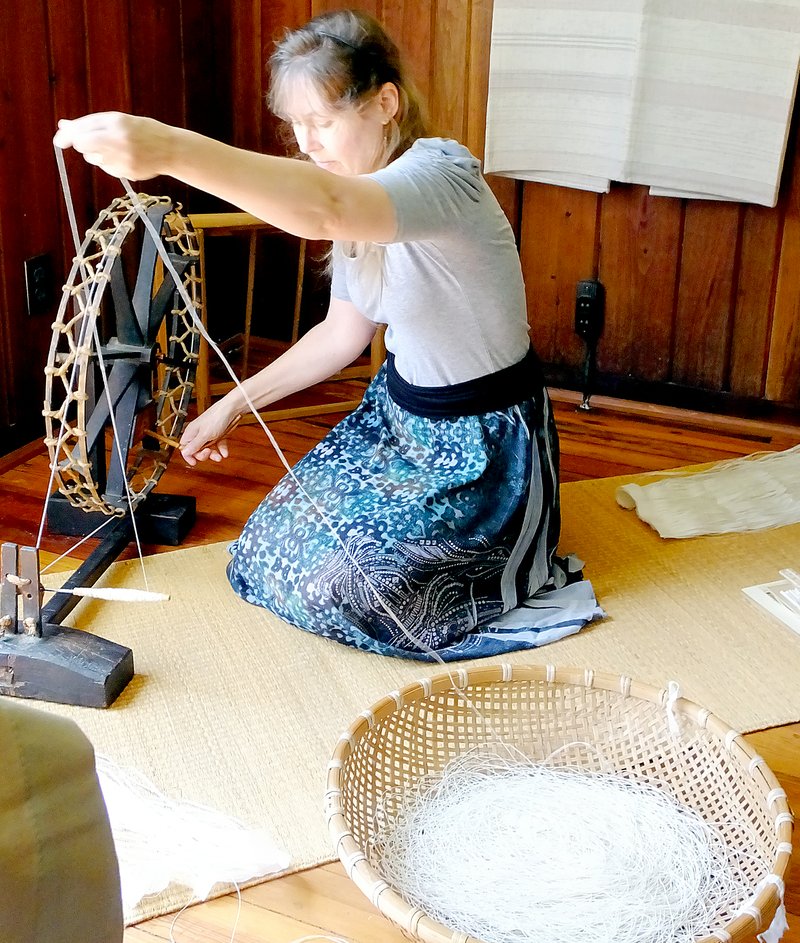A year in Japan as an art student gave Susan Byrd a lifetime passion for a craft that is slowly disappearing.
Recently, Byrd published a book, "A Song of Praise for Shifu," about the art of weaving paper cloth. In her Bella Vista backyard, she built a Japanese tea house that also is dedicated to shifu.
"There are four principles of a tea ceremony -- harmony (wa), respect (kei), purity (sei) and tranquility (jaku) -- all of which are attributes of shifu," she wrote on her webpage, www.byrdsnest.net.
Although she doesn't know all the intricacies of a formal tea ceremony, she has been present at some and brought back some of the utensils used, including a whisk and ladle made of bamboo.
Her tea house -- a 10- by 12-foot structure sided with cedar with a view of Lake Brittany through the large glass doors -- is furnished with four cushions around a sunken hearth. A teapot and the apparatus to hang it over a fire are centered in the bright room. She brings the water from her kitchen.
The tea house, the book and the trips to Japan started when Byrd decided to make her own paper for her pen and ink drawings. She spent a year in Japan practicing paper-making techniques, and that's when she met Sadako Sakurai, one of very few artists who still work with shifu. Byrd was hooked immediately.
A temporary exhibit at The Artist Retreat Center, in the old Linebarger cabin on Bella Vista Way, gave her a chance Sept. 6 to explain shifu. She took most of her tools and several samples she brought back from Japan over the years.
It begins, she said, with a piece of tissue-like Japanese paper. Traditionally, paper -- including old account books -- was recycled into shifu, although some items were made with new, specially produced paper. It's still possible to buy paper made for shifu, she said.
A precision knife is used to cut the paper into thin strips, leaving a margin uncut at both the top and the bottom. By carefully pairing the strips, ripping through first the top section and then moving over one strip and ripping through the bottom section, one long narrow strip is formed out of what was a rectangle.
The paper is spun into threads with a Japanese spinning wheel that sits on the floor. The strips are dampened and twisted tight by the wheel. The paper thread is then put on a loom for weaving.
Some shifu cloth is made with silk as the weft -- the horizontal threads -- and paper as the warp -- the vertical threads. But sometimes only paper thread is used.
If recycled paper is used, the ink makes a random pattern on the finished fabric.
When Japan was still a closed, completely self-reliant society, farmers made paper each winter, and some of that paper became clothing in later years. If it's well made, shifu fabric can be washable, Byrd said.
"It's a humble cloth like the tea ceremony is humble," she said.
Later, Byrd returned to Japan to learn how to dye shifu fabric with natural materials like indigo plants and walnuts.
Since her first visit to Japan in the 1980s, Byrd has worked with other materials, such as items found on Glass Beach in Fort Bragg, Calif. Now a state park, Glass Beach is where trash, once dumped in the ocean, had washed up onto the beach.
The ocean broke household items apart and changed them by the constant motion of the saltwater. Creating "boro art" -- art made with scrap materials -- is a lot like shifu, she said.
Last year, she traveled to Japan and was disappointed that so many Japanese didn't know about shifu. Even in one of the castle towns that had once been renowned for the craft, people don't remember. She's hoping her book will help keep the craft from disappearing.
The book was published by The Legacy Press and can be purchased on its website, www.thelegacypress.com. It has already received several awards.
Byrd is happy to share her love of shifu, and she can be contacted through her website.
Community on 09/17/2014
